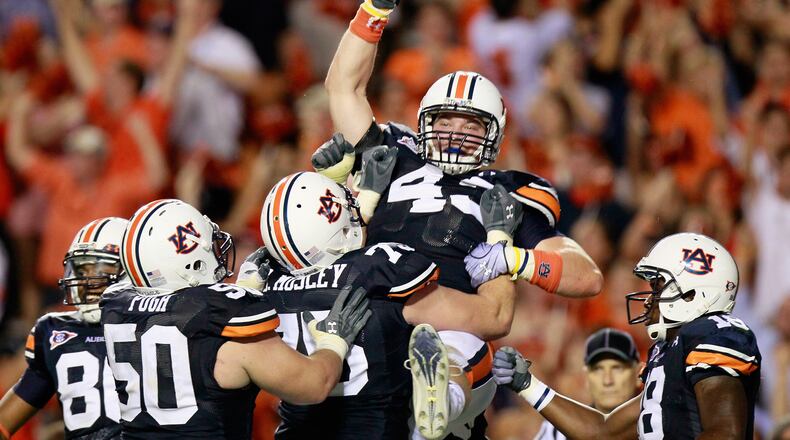It has been more than four years since Philip Lutzenkirchen, the former populist tight end at Lassiter High and Auburn, died in a single-car accident on a Georgia country road during an early morning of bad decisions.
Four years, three months and 25 days to be exact, that his family has been trying to make sense of the senseless.
As time passes and the sharp edges of that day inevitably wear away, Philip’s father, Mike Lutzenkirchen, has made it a mission to keep the pointed and painful lessons of his 23-year-old son’s death relevant.
So, cut to Monday and the Atlanta headquarters of the Arthur Blank Foundation. Another campaign had begun. This one aimed at combating the dangers of distracted and impaired driving, called 43 Key Seconds. Forty-three was Philip’s number.
» Photos: Philip Lutzenkirchen on the field
This campaign would add distracted driving to the list of warnings that Philip’s death sounded: He and the driver of the car that day were drunk; he hadn’t used his seat belt and was ejected when the car sped off the road.
The 43 Key Seconds refers to the moments between getting behind the wheel and turning the key in which drivers might review an internal checklist that could save some lives. Are you clear-headed? Have you stowed the cellphone, are you hands-free? Are you alert? Have you buckled up?
The symbol of this campaign will be a small key imprinted with the 43 Key Seconds reminder that Mike hopes to hand out in the millions as he continues to travel the country and speak on the subject. The idea is to make the key a tangible, visible and ubiquitous symbol for sober, serious driving – rather like what the Livestrong band was to cancer fund-raising and awareness.
The intended audience for the message isn’t exactly the 76-year-old owner of the Falcons and Atlanta United – and he was also pretty big in hardware – whose foundation awarded a large grant to the effort this week.
“They all call me the worst driver in the family to begin with, so I’ve got to be careful,” Arthur Blank said. “And you know at my age, you do have to be careful. I focus on driving and I drive much slower than I’ve ever driven before.
“My children, I worry about them because of all this texting business. They assure me they don’t, and I trust them that they don’t. But any form of distracted driving is a real issue.”
It’s young drivers, whose top priority when getting behind the wheel often isn’t on actually driving a car, who are the targets. The ones who feel particularly invulnerable, when, in fact, they are among the most vulnerable.
Getting that message through that generation of skulls, “is going to be difficult,” Mike Lutzenkirchen said.
But, then he remembers the potential power of the many speeches and presentations he makes. “When you can look them in the eye and you can watch them see a video that shows them who Philip is as a person,” he said. “When they start getting distracted in that talk you can pull them back real quick about all the wonderful things Philip did, but these things took his life. Envision because of your poor decisions your father in my shoes.”
A daughter of Blank’s wife, Angela, had gone to school with Philip. Later meeting his parents, Blank learned more of the story. Immediately, his message to Mike and Mary Lutzenkirchen was: “It’s an incredible story and your passion is incredible and you have a great delivery. You can make a difference.”
Here was another platform for Philip’s father to make his very personal appeal for more safety and sanity behind the wheel.
“You think of the words crisis or epidemic, those are extremely strong words. (Dangerous driving) is truly an epidemic and a crisis,” he said.
His son and his story still have a role to play moving forward. One little key is out there now to serve as the nagging reminder to drive safely and smartly, coming as it does from a source of loss and grief that never fades, no matter how many years pass. There’s more work to do for No. 43.
“I believe in 18 to 24 months when people see 43 they’re going to associate that with not being an impaired or distracted driver,” Mike said.
About the Author
The Latest
Featured



